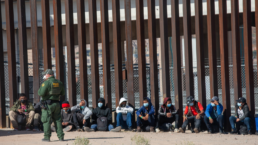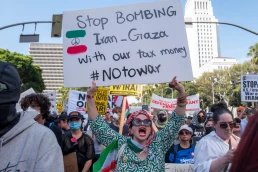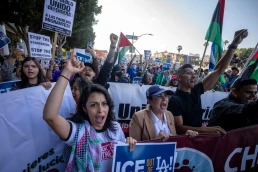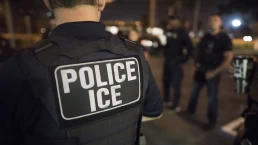Putting out the welcome mat for white Christians—while slamming the door in the faces of other migrants—is an American tradition.
By David Nasaw, The Nation
The numbers speak for themselves.
Two months after the Russian invasion, more than 5 million Ukrainians have fled their nation: 2.8 million to Poland, 757,000 to Romania, 426,000 to Moldova, 471,000 to Hungary, 342,000 to Slovakia. Many have made their way to the other nations in the European Union, which have offered them “visa-free entry.” Others are planning to fly to Canada, which has authorized what it calls a “special, accelerated temporary residence pathway for Ukrainians seeking safe haven.” Under this program, an unlimited number of refugees will be allowed to stay, work, and study in Canada for up to three years.

And the United States? On March 24, 2022, President Joe Biden announced that the US would “welcome up to 100,000 Ukrainians and others fleeing Russia’s aggression through the full range of legal pathways, including the U.S. Refugee Admissions Program.” Programs would be developed and expanded “with a focus on welcoming Ukrainians who have family members in the United States.”
Mark Hetfield, the president and CEO of HIAS, one of the principal organizations providing humanitarian assistance to Ukrainians, spoke for many refugee advocates when he applauded Biden’s announcement—which came a month after the invasion and weeks after the European nations and Canada had set out their own refuge and resettlement plans. He cautioned, however, that “the devil and the angel [will be] in the details.”
Only on Thursday, April 21, almost two months after the Russian invasion, did the Biden administration announce plans to expedite Ukrainian resettlement by permitting US citizens and organizations to sponsor selected refugees, who, if they pass rigorous screening and security checks, would be allowed to remain in the country for two years. We have few details on how this program will work, only unanswered questions. If Ukrainians with American sponsors and those already in the country are given precedence, how many of the 100,000 allocated slots will be left for other refugees? Will Africans and others who have resided, worked, or studied in Ukraine but have no Ukrainian passport be eligible? When will the process be set in motion? When should we expect the refugees to arrive?
What they are not told is that, according to the National Immigration Forum, the process of applying for refugee status and getting into the US “has grown increasingly complicated…encompassing numerous government agencies, at least five separate information technology systems, and a trove of inscrutable acronyms…. UNHCR currently estimates the process from referral to resettlement…to take between two and 10 years.”
Recent Posts
Is A Citizens United 2.0 Right Around The Corner?
July 15, 2025
Take Action Now Is it possible for American democracy to be further degraded by the influence of billionaires? Thanks to champion of the working…
U.S. Leaders Gave Up On Diplomacy With Iran. We Must Make Them Return To It.
July 15, 2025
Take Action Now Building an antiwar movement means preventing the systemic U.S. aggression that creates the conditions for war.By Hanieh Jodat,…
What To Do When You See ICE In Your Neighborhood
July 14, 2025
Take Action Now How can you deter the Trump administration’s immigrant deportation machine when it pops up in your community? Follow these…
ICE Campaign Of Violence Will Lead To More Deaths
July 14, 2025
Take Action Now Jaime Alanis’s death shows the horrific consequences of a secret police force behaving with utter impunity.By Natasha Lennard, The…




